Last Update:
 Hey, there!
Hey, there!
In this article we’ll help you in finding the best guitar tuner for your guitar and give you tips on using it! You’ll find all the information right from the first step of finding a great guitar tuner and buying it to the final step of tuning your guitar using it.
Table of Contents
Best Guitar Tuner Buying Guide
Six Things To Keep In Mind to Find The Best Guitar Tuner
When you are playing your guitar, it is very important that your guitar is in tune to produce great sound. And using a guitar tuner is the best way to make your guitar sounds well. Consider the following things before you buy guitar tuner to find a tuner that suits your requirements and comes under your budget.
1. Power Supply
Before you buy guitar tuner, it is best to check its power reliability. Most of the guitar tuners come with a battery or a power outlet. So before you buy guitar tuner make sure you research about the power source for the tuner. It’s always better to buy one with battery as you can use it anywhere you want without the need of a power outlet. Just keep a battery in reserve so that you don’t end up with a dead device when the battery runs out.
2. Ease Of Use
Another point to take care of before you buy guitar tuner is the ease of use. It’s important as you’ll not want to waste your time on tuning your guitar as the most important thing is to play the guitar rather that tuning it. So a guitar tuner should be easy to use,
4. Display
It is always better to pick a tuner that has a readable display and an LED and LCD displays can provide you with this requirement. There are a lot of types of displays out there – LED displays with single or multi backlight or LCD with multi-color display. It’s always up to you to pick one that suits your needs the best. We always prefer tuners with multicolor and and bright display like
5. Robust Body
This is the thing you should always take care of when buying a guitar tuner. As guitar tuners are small and often used roughly the body should be robust enough to withstand jerks and vibration. This also ensures greater like of your tuner. There are broadly two types of tuners in terms of the material it is made up of – plastic or metal.
6. Price
There are a lot of types of guitar tuners present out there for almost every pocket size – from very cheap to very pricey. They basically differ in the features they provide. So if you just want a plain and simple guitar tuner it won’t cost you more than just $10 or so. But if you are a pro user and would love to have have more features then you may have to spend more.
There are a lot of brands out there in the market, so before you buy guitar tuner make sure that you choose one by considering the above given points. You may also consider the size of the tuner and its accuracy in that matter. These days, you can buy a tuner in almost every size and most of them are very accurate and precise.
3 Types of Guitar Tuners
With so many different kinds of guitar tuners in the market, how do you decide which to get? The three most common types of tuners are vibration, strobe and microphone. These can range from freestanding, pedal tuners or clip-on tuners to sound hole and very compact attachable tuners now a days. We have covered these different types of tuners with their differences below:
Type #1 – Vibration (Piezo)
If you need to tune your guitar is a noisy place the vibration type guitar tuner is the way to go. These are especially helpful when you are on stage, performing in a noisy environment. These types of tuners are clipped directly onto the guitar. They pick up the vibration of the tone played by the guitar and tell if the string is in tune. Most of them don’t have microphone to detect tone. They come in different variety by basically work on the same principle of detection of vibration.
These tuners cover a broad spectrum of available products and they come in a variety of designs and shapes. You can buy cheap tuners with less features or if you are willing, you can pay more for to get more advanced and new features. There are always new styles and designs coming out a lot of new features. These range from very cheap tuners to very pricey ones.
Type #2 – Strobe (Stroboscopic)
The strobe tuner is a very old type of tuner and it has been in market since 1936. But don’t get confused, it is the most accurate type of tuner available. This type of acoustic guitar tuner compares the note played with a reference frequency. If there is a frequency difference the disc inside the tuner rotates. On the other hand when the frequency of the note is same as the tuner, the disc remains still. What this means is that the accuracy of the tuner is as good as the internal frequency, which should be spot on.
Now a days these type of tuners have LED display instead of the disc but they are as accurate as always were. These guitar tuners are used by plugging the instrument into the device. They can be somewhat pricey but remain accurate for a long period of time.
Type #3 – Microphone
When people think of tuners, what they probably think of is microphone style tuners. These are the tuners that you play at and it picks up the tone. They completely rely on the sound of the string played and not the vibrations. These can be freestanding, clip-on, pedal style or other new types of tuners.
The only thing to remember is that with these types of tuners you will want to make sure the area around you is fairly quiet. Any surrounding noise can distract the readings so you should make sure that you don’t have any surrounding noises.
You will have the most choices when it comes to selecting a microphone acoustic guitar tuner. These contain an internal mic that senses the sound. While these aren’t as accurate as its counterpart, you will have a greater choice in functionality and features and price range. The price range is wide so you can find one that fits your needs and pocket as well!
Just think of three things: affordable reliability (vibration type), accuracy (strobe type tuner) or options (microphone type). No matter what tuner you pick, make sure you get the tune you need when and where you need it.
10 Best Guitar Tuners in India
After researching a lot about guitar tuners present out there we have finally decided on 10 guitar tuners that we love the most. In this article we have reviewed those 10 best guitar tuners.
We have used a lot of parameter to review them including ease of use, accuracy, features, battery back-up, value for money etc. This is by far the best review of top guitar tuners you’ll find on the web. We highly recommend that you read this review first before buying any guitar tuner.
1. Snark SN-8 Super Tight All Instrument Tuner
 Features:
Features:
- Tuner Type – chromatic clip-on tuner
- Display – Brighter EZ Read Display
- Super Tight Tuning
- 360-degree rotation possible
- Faster Display
- Tap Tempo Metronome
- Pitch Calibration and Transpose Features
What We Loved (Pros):
The Snark Tuner has been a very reliable guitar tuner for many guitarists. It is one of the most known tuners around. It features a super-tight grip clip that would hold onto any headstock for any kind of guitar. It also faster when picking up vibrations.
What Could Have Been Better (Cons):
The only thing with the tuner is that it’s quite brittle and the mount can be easily damaged when dropped.
2. D’Addario PW-CT-15 NS Micro Soundhole Tuner
 Features:
Features:
- Tuner Type – chromatic conceal clip-on tuner
- Display – multi-color display
- On-marring sound hole clip
- Calibration range of 435 – 445 Hz.
- Concealing Tuner
- Display
- Stress-free installation
- Pitch Calibration and Transpose Features
What We Loved (Pros):
The D’Addario PW-CT-15 NS Micro Soundhole Tuner is a perfect tuner engineered for any acoustic instrument– namely acoustic guitar, acoustic bass, ukulele; among others. It has a quick and accurate response, a non-marring sound hole clip, a multi-color display with a calibration range of 435 – 445 Hz.
What Could Have Been Better (Cons):
The display can be somehow small for others. Thus the hard time looking at the display.
Check Price on Amazon3. So There Rechargeable Clip-on Tuner
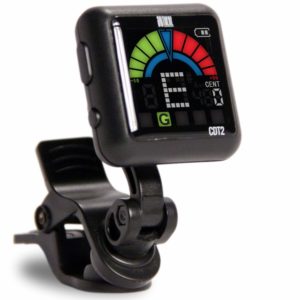 Features:
Features:
- Tuner Type – chromatic clip-on tuner
- Display – multicolored led display
- Rechargeable batteries
- Over 5 hours of power
- Clip-on Mount
- Display
- Pitch Calibration and Transpose Features
What We Loved (Pros):
You can get over 5 hours of power with the “So There Rechargeable Tuner”. It’s a tuner made only for ease of use, turn it on and tune! No need for any hassle and to find batteries ever again, you can also quickly recharge your tuner with the inclusion of a micro-USB cable for it. The tuner is also super-fast, and super accurate with a wide variety of instrument that can be compatible with it. From guitar, bass, ukulele, violin, and any other stringed instrument, the tuner is the one to call.
What Could Have Been Better (Cons):
The Tuner can be better with more features of calibration and Hrz Adjustments
Check Price on Amazon4. Korg AW2G Clip-on Chromatic Guitar Tuner
F eatures:
eatures:
- Tuner Type – chromatic clip-on tuner
- Display – internal backlight
- Optimized clip
- Double ball-joint
- Multi-angle positioning
- Display
- Energy-saving auto mode
- Pitch Calibration and Transpose Features
What We Loved (Pros):
The Korg AW2g Clip-on tuner has been known for many musicians of different genres as one of the most reliable tuners around. It attaches directly into your stringed instrument for cable-free tuning. It also has an optimized clip for attaching it to a guitar headstock. The tuner has a double ball-joint that allows it for multi-angle positioning with greater mobility and is for good display section.
The internal backlight ensures excellent visibility even on a dimly lit stage. Moreover, it has an energy-saving auto mode that automatically switches to the low-power Soft mode when no sound is present.
What Could Have Been Better (Cons):
The display can be very different and if you have seen and used different ones you’ll need some time on getting used to this particular one.
Check Price on Amazon5. ChromaCast 440 Series CC-440-SGR Guitar Tuner
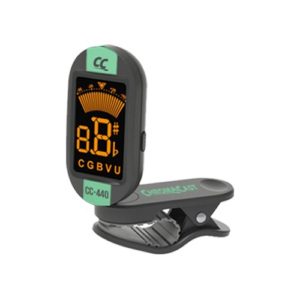 Features:
Features:
- Tuner Type – chromatic clip-on tuner
- Display – multi-color display
- 360-degree positioning view
- Calibration range of 435 – 445 Hz.
- Display
- Stress-free installation
What We Loved (Pros):
The ChromaCast 440 is a tuner worthy for all, and by that — I mean all variations of instruments– from bass, ukulele, guitars, stringed instruments, woodwind and as well as to brass instruments. The tuner is built to be very flexible and precise! It also features a 360-degree positioning view perfect for easy viewing and is available on many kinds of design and color (Daphne blue, Surf Green, Sunset Orange, and Vanilla Cream). The tuner is imported in the US, thus making it high-quality standard.
What Could Have Been Better (Cons):
The display is barely visible on outside stages and on direct sunlight. They can work on the display of this particular tuner.
Check Price on Amazon6. Musedo T-40 Clip Style Auto Tuner
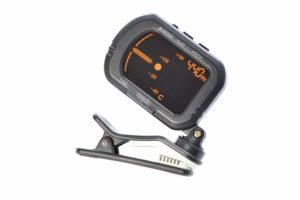 Features:
Features:
- Tuner Type – chromatic clip-on tuner
- Display – advanced color LCD
- 27.5 to 4186Hz tuning mode
- Calibration range of 435 – 445 Hz.
- Clip-on
- Display
- Pitch Calibration and Transpose Features
What We Loved (Pros):
The Musedo T-40 Clip Style tuner is a chromatic tuner that has 27.5 to 4186Hz tuning mode. A chromatic tuner for the guitar, violin, bass, and both for keys of C and D ukuleles, this tuner is really cheap but also reliable as the others. Both precise and accurate, this tuner works with complete ease!
What Could Have Been Better (Cons):
Sometimes, it takes time to read the notes while tuning and is a hassle in some cases. But efficiency-wise, it’s really good and accurate. Also, the clamp could’ve been made better and more flexible.
Check Price on Amazon7. GuitarSense GS-T1 – Guitar Tuner Clip
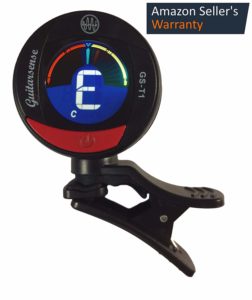 Features:
Features:
- Tuner Type – chromatic clip-on tuner
- Display – multi-color display
- Piezoelectric sensor
- A4 Frequency for 440Hz
- 20ms response time
- Display
What We Loved (Pros):
You can easily take away the stress and the pain of tuning an instrument with the GuitarSense GS0T!- guitar tuner. It is both fast and accurate and is really easy to use for your loved instrument’s intonation.
The tuner is used for many kinds of instruments– from guitar, bass, violin, ukulele, banjo, and any other stringed instrument. It is fairly intuitive to use, having the advance Piezoelectric sensor, which is quick with a 20ms response time. It also features an A4 Frequency for 440Hz wide frequency range and is powered with coin batteries. The tuner is stress-free and is really easy to use!
What Could Have Been Better (Cons):
The sensor can be better on other instruments such as the violin or other stringed instruments. It lacks a bit of accuracy when it comes to these instruments.
Check Price on Amazon8. Korg AW3G2BK PitchHawk G2 Clip-On Guitar Tune
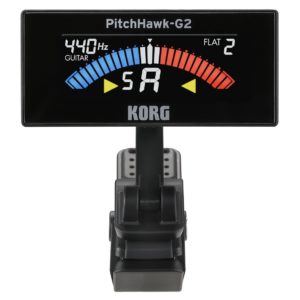 Features:
Features:
- Tuner Type – chromatic clip-on tuner
- Display – advanced color LCD
- Slimmer, easier to use design
- Calibration range of 435 – 445 Hz.
- Provides flat/capo settings
- Display
- Pitch Calibration and Transpose Features
- Strong holding clip power
What We Loved (Pros):
The Korg PitchHawk G2 tuner is a really good tuner for the guitar playing musician. With an advanced color LCD, it provides a whole new dimension of viewing and visibility. It also has a slimmer and elegant design, yet easier and more flexible for the users. It is dedicated for guitar and bass modes that tunes the instruments with great accuracy and precision, with a clip mechanism that provides a very strong holding power for the headstock. The Korg company has improved the design and the quality of this particular tuner.
What Could Have Been Better (Cons):
This particular tuner is a blessing for guitar players. The only thing is the batteries, so always bring extras so when it shuts down, you can always replace the old batteries.
Check Price on Amazon9. Korg Sledgehammer Pro Guitar Tuner
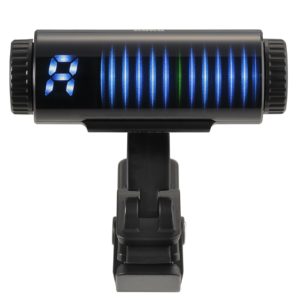 Features:
Features:
- Tuner Type – chromatic clip-on tuner
- Display – multi-color LCD
- Memory backup function
- Ubular visual meter
- 3D view
- Rotatable shuttle switch
- High accuracy tuning of +/- 0.1 cents
- Calibration, auto power-off.
What We Loved (Pros):
This tuner is highly sophisticated with a tubular visual meter that provides the user a 3D view and visibility for the screen. It is also loaded with a rotatable shuttle switch with high accuracy tuning of +/- 0.1 cents. The calibration for the Korg SledgeHammer is with an auto power and off memory backup function.
What Could Have Been Better (Cons):
Some folks don’t like the looks and aesthetics of this particular tuner.
Check Price on Amazon10. Matrix 3D Clip-on Chromatic, Bass, Violin, and Ukulele Guitar Tuner
 Features:
Features:
- Tuner Type – chromatic clip-on tuner
- Display – multi-color display
- Multi-instrument tuner
- Calibration range of 436 to 445 Hrz
- Flexible
- Pitch Calibration and Transpose Features
- Easy to read color changing 3D display
- Tuning range: B0-B7
What We Loved (Pros):
The Matrix 3d clip-on tuner is a tuner like no other, it focuses on flexibility and of course a wide variety of musical instruments. The tuner can tune all instrument from bass, guitar, violin, ukulele and any other musical instrument from wind and also to brass ones. It is calibrated for 436 to 445 Hrz and is really a tuner worth spending on.
What Could Have Been Better (Cons):
the only thing with this tuner is its durability. It can be a disaster for the screen if it falls on the floor. Thus the need for protection on this particular tuner.
Check Price on AmazonNoteworthy Mention
The following is not a clip on guitar tuner but a metronome. It’s quite popular and does a couple of more things apart from justing helping you tune your guitar.
11. GUITARX X7 – Guitar Tuner Metronome
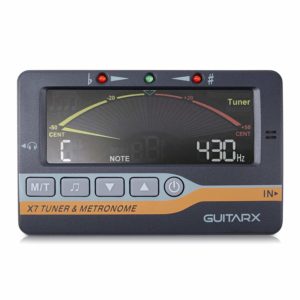 Features:
Features:
- Tuner Type – chromatic tuner/metronome
- Display – multi-color LCD display
- Multi-instrument tuner
- Calibration range of 430 to 445 Hrz
- Metronome
- Pitch Calibration and Transpose Features
- Single unit tuner
- Low to high tuning frequencies
What We Loved (Pros):
The guitar X7 Is both tuner and metronome packed in one single unit. The tuner is really accurate and fast! Having to have different contrast of colors on the screens and also features a very reliable available multiple rhythm sensor. It also has a tone generator for comparing pitch and tone on instruments.
What Could Have Been Better (Cons):
The only thing with this tuner is that you can’t attach it to the headstock of your guitar.
Check Price on AmazonHow to tune your guitar?
Using a guitar tuner is the easiest and one of the most efficient ways of tuning an acoustic guitar. Most acoustic guitar tuners today are very inexpensive. An acoustic guitar tuner uses a small microphone or other hardware (like in case of piezo and strobe tuners) which picks up the note strummed on the acoustic guitar and display it on the tuner display.
The tuning of the strings is then altered using the tuning pegs to tune it to a particular note. There are dozens of tuning combinations in which we can tune our guitar, but the standard tuning for a guitar is :
E – A – D – G – B – e
With “E” being the tuning of the thickest string all the way to “e” being the tuning of the thinnest string. By reading the following step by step guide you will be able to tune your acoustic guitar quickly and easily so that you can start playing your favorite songs in no time.
Tuning your acoustic guitar may be difficult at first but it will become your second nature with more practice. Just keep this in mind and follow the instructions below
Step-by-Step instructions on tuning your guitar
- Get your guitar tuner.
- Clip the tuner to your guitar or place in on a table close to your guitar.
- Pluck the strings one by one starting with the thinnest string and see the tuning on the acoustic guitar tuner display.
- Look at the indicator on the display. It will show you how close your string’s tuning is to the original tuning of that string.
- Adjust the tuning of the string of your acoustic guitar by turning the tuning pegs to loosen or tighten the string.
- Repeat the above procedure for all strings to tune then according to their original tunings.
- Once you have tuned all the strings, tune them once again from the thinnest string to the thickest to make sure all the strings are perfectly tuned.
Tips On Tuning Guitar
Following are some simple guitar tuning tips that we feel every guitarist should take care of when tuning his/her guitar. Now it does not matter if you have an acoustic guitar or an electric guitar, these tips applies to both.
- When tuning your guitar using an online guitar tuner, make sure the volume of the guitar tuner and tune played by the tuner have same volume. It will help you to easily tune your guitar and with greater accuracy.
- Always tune up. This means that when you need to tune a string to a desired note, gradually tighten the string to reach to the note and not loosen it.
- Always tune from thinnest string to the thickest string. And repeat the process at least twice to make sure the tuning is perfect.
- Always keep your guitar tuned before playing. It does not take more than a minute or two to do it.
- Don’t keep your guitar in moist or high temperature places as this may lead to permanent bending of your guitar’s neck which will make it harder for you to tune it. Keep your guitar in case whenever possible.
- Always un-tune your guitar when you’re not playing it for a long duration of time as this may also lead to bending of guitar’s neck.
- Use only piezo-type guitar tuners when tuning in noisy places to make sure you can tune your guitar.
- To test if you have tuned the guitar perfectly, play a chord that you are familiar and listen if it sounds perfect. If it doesn’t, tune the guitar again.
We hope you found this useful.


